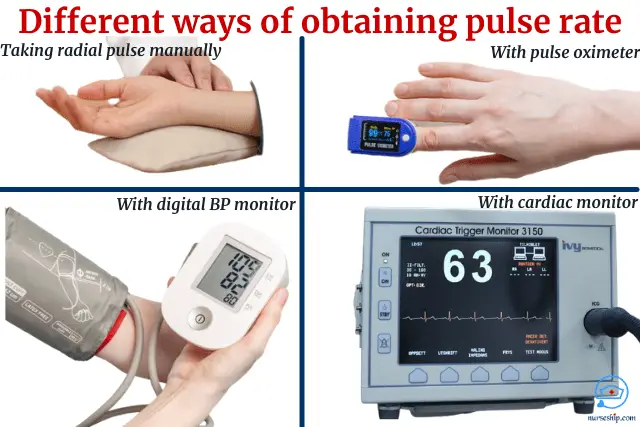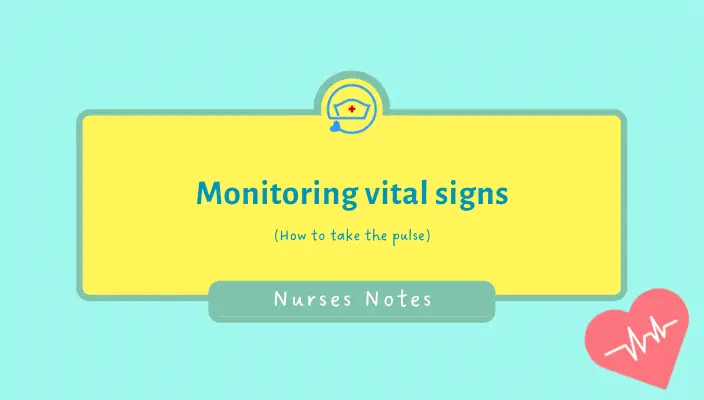Last updated on December 28th, 2023
Monitoring vital signs (vitals) are essential for planning and prioritizing nursing interventions.
Because it gives vital information about basic bodily functions of the client.
Most commonly measured vitals signs are:
- Pulse rate (PR) or Heart rate (HR)
- Temperature
- Respiratory rate (RR)
- Blood pressure (BP)
Here, we’ll discuss how to measure pulse rate and its purposes.
We’ll discuss the remaining vital signs in upcoming articles.
Click here to learn more about characteristics and factors affecting pulse rate.
Purpose of taking pulse
The purpose of measuring pulse rate include:
- To establish baseline data
- To determine the number of heartbeats per minute
- To check abnormalities in rate, rhythm, and volume
- To monitor any changes in the health status of the client
- To assess the response of the heart to cardiac medications, activity, and blood volume
- To check the peripheral circulation
Monitoring and care
If you are assessing a client’s pulse for the first time, establish the radial pulse as a baseline.
The radial pulse is strong, firm, and regular.
Compare the pulse rate and character with the client’s previous baseline data. Also, determine whether it is within an acceptable range for the client’s age.
Compare the pulse bilaterally (eg: take left and right radial pulse together).
Assess, treat, and reassess pain and other stressors that affect pulse rate.
Normal pulse rate has a regular rhythm and strength of 3+.
Unexpected outcomes
- Absent, difficult to palpate, faint, weak, or feeble pulse
- Tachycardia – Abnormally high pulse rate (For adults greater than 100 bpm, See normal pulse rate according to age)
- Bradycardia – Abnormally low pulse rate (for adults less than 60 bpm, See normal pulse rate according to age)
- Irregular rhythm
Pediatric considerations
Accurate radial pulse can be measured from clients older than 2 years of age.
Children often have a sinus arrhythmia – an irregular heartbeat that increases with inspiration and slows with expiration.
Breath holding in a child affects the pulse rate.
Gerontological considerations
Feeling the pulse of an older adult or obese patient can be difficult.
The elasticity of arteries reduces as we age. So, you may feel stiff and knotty when palpating an older adult’s pulse.
The pulse rate takes longer to elevate to meet sudden increased demands caused by stress, illness, or excitement in elderly.
Also it takes a longer duration to return to normal range.
Home care considerations
- Train the patient and caretaker properly to take pulse if home monitoring pulse is needed.
- Have multiple return demonstrations before discharge to ensure correct measurement of pulse.
- Teach the patient and family the abnormal values that require immediate attention.
How to measure the pulse rate
Pulse rate can be measured either manually or digitally using an equipment.
The picture below shows different ways of obtaining pulse rate.

Here, we’ll learn how to take the pulse rate manually for nurses.
Equipment needed to measure pulse
- Watch with second hand
- An appropriate chart to document
Procedure for taking pulse
- Before taking the pulse, explain the procedure to the client. This is to obtain informed consent from the client and reduce anxiety.
- Wash your hands thoroughly to minimize the risk of cross-infection.
- Gently place fingertips (index and middle finger) over the selected artery. Then apply slight pressure and feel for the pulse. This helps to locate the position and to identify the pulse.
- Don’t put too much pressure because it may block the blood flow and you will not feel the pulse.
- Once you have located the pulse, count for 60 seconds.
- Observe the rate, rhythm, and intensity of the pulse to identify any abnormalities (eg: irregular, absent, thready, weak, strong, or bounding).
- Determine the intensity of the pulse and grade it on a scale of 0-4 (eg: 0, 1+, 2+, 3+, 4+). Be cautious and as accurate as possible when assessing subjective data.
- Note any changes from the previous assessments. If applicable, notify the physician.
- Wash your hands after the procedure to minimize the risk of cross-infection.
- Document the findings.
Documentation tips
- Pulse rate
- Pulse rates before and after administration of specific therapies
- Pulse intensity (e.g., 0, 1+, 2+, 3+, 4+)
- Abnormal findings
- Patient and family education
- Unexpected outcomes and related nursing interventions
- Pain assessment and management
Bonus Tips
☞ Clients with regular pulse, you may count pulse for 30 seconds and multiply it by 2 to get pulse rate.
For example, you felt 32 pulsations for 30 seconds.
Calculation – 32 X 2 = 64.
Which means the patient’s pulse rate is 64 bpm (64/min).
☞ Or, you may count pulse for 15 seconds and multiply it by 4 to get pulse rate.
For example, you felt 20 pulsations for 15 seconds.
Calculation – 20 X 4 = 80.
Which means the patient’s pulse rate is 80 bpm (80/min).
☞ If the client has an irregular pulse, always count for 1 full minute.
☞ Don’t use your thumb to measure pulse because you may feel your own pulse.
Conclusion
In conclusion, monitoring pulse rate is a key component of vital signs that provide valuable information about the cardiovascular system.
As nurses, we must master the skill of taking pulse and other vitals to ensure accuracy of our assessments.
Additionally, we should also be aware of the factors affecting pulse rate. So, we can plan and implement nursing care appropriately.
Learn more ☞ pulse points and factors affecting pulse rate.
Reference
Hilton, P. (2005). Fundamental nursing skills. London: Whurr Publishers.
Perry, A.G., Potter, P.A., Ostendorf, W.R. (2018). Clinical nursing skills & techniques (9th ed.). Elsevier: St. Louis.



Comments are closed.